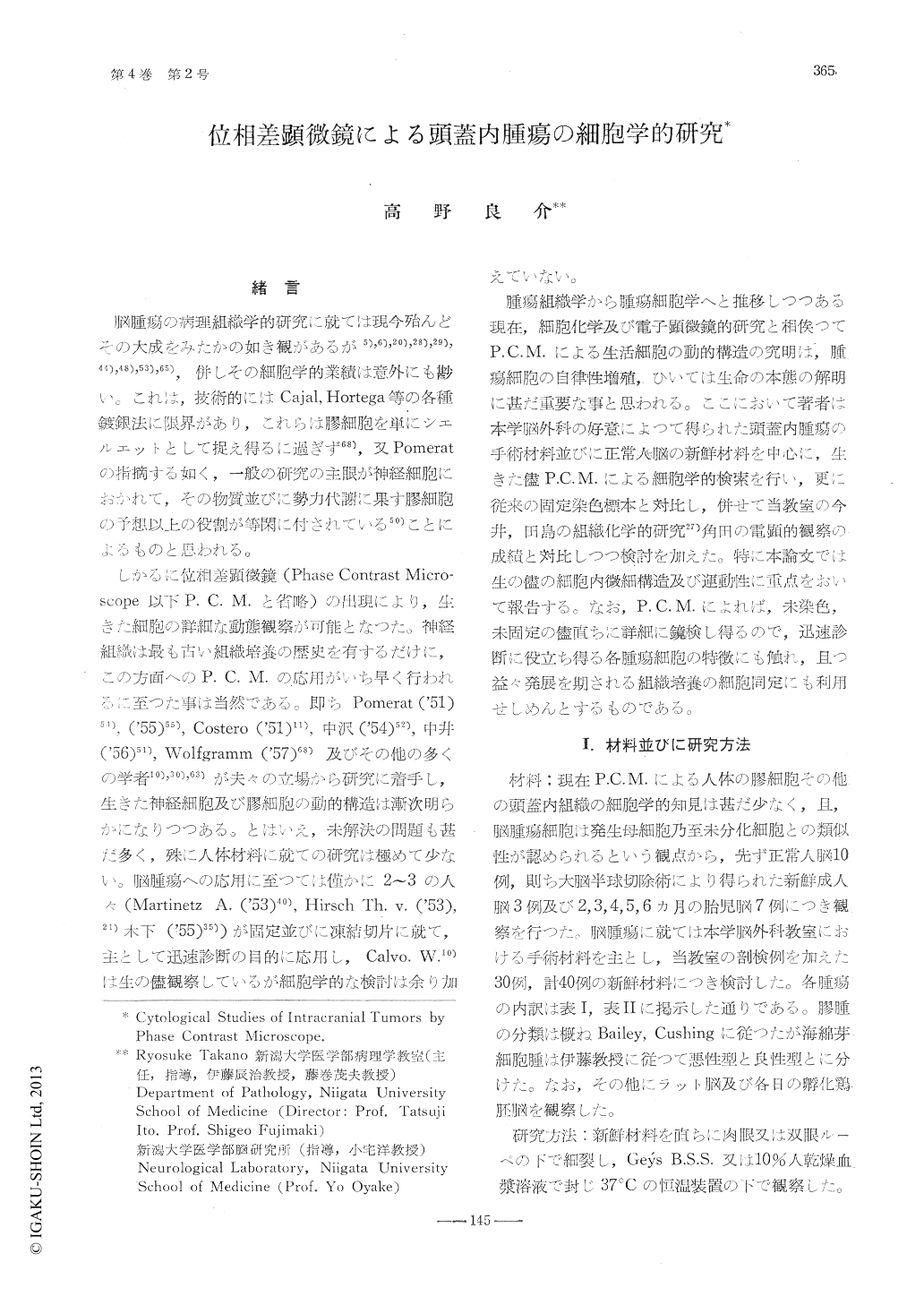Japanese
English
- 有料閲覧
- Abstract 文献概要
- 1ページ目 Look Inside
緒言
脳腫瘍の病理組織学的研究に就ては現今殆んどその大成をみたかの如き観があるが5),6),20),28),29),44),45),53),65),併しその細胞学的業績は意外にも尠い。これは,按術的にはCajal,Hortega等の各種鍍銀法に限界があり,これらは膠細胞を単にシエルエットとして捉え得るに過ぎず68),又Pomeratの指摘する如く,一般の研究の主限が神経細胞におかれて,その物質並びに勢力代謝に果す膠細胞の予想以上の役割が等閑に付さねている50)ことによるものと思われる。
しかるに位相差顕微鏡(Phase Contrast Microscope以下P. C. M.と省略)の出現により,生きた細胞の詳細な動態観察が可能となつた。神経組織は最も古い組織培養の歴史を有するだけに,この方面へのP. C. M.の応用がいち早く行われるに至つた事は当然である。即ちPomerat('51)54),('55)55),Costero('51)11),中沢('54)52),中井('56)51),Wolfgramm('57)68)及びその他の多くの学者10),30),63)が夫々の立場から研究に着手し,生きた神経細胞及び膠細胞の動的構造は漸次明らかになりつつある。
Most of the cytological studies of neurogliaand brain tumors have been carried out chieflyby means of silver impregnation methods ofCajal, Hortega et al. However, these methodshave limited value, and, on the contrary, thephase contrast microscopy (P.C.M.) is veryuseful and informative to study internal finestructures of neuroglia and tumor cells, especially in living state.
The author has observed fresh surgicalspecimens of brain tumors (30-cases), normaladult and embryonic human brains and ratbrains by P. C. M. in comparison with routinepreparations. The main features are as follows:-
A. Gliomas; Medulloblastoma cells have ashort process which often shows branching ormembrane formation, suggesting membrane activity of the cells. Nuclear membrane is delicateand cytoplasm is scanty. Glioblastoma cells arevery polymorphous and have often sprouted, segmented and plural nuclei with distinct nucleoli. Sometimes they show phagocytosis ofblood cell. Spongioblastoma cells have 1-3 stoutprocesses with fine side branches, with whichthey seem to he connected each other. Fibrousastrocytoma cells give off many fine processesmore numerous and finer comparing with routinepreparations. These processes are often connected with their side branches. Protoplasmicastrocytoma cells have large, light cytoplasmwith thick processes. The processes of oligodroglioma cells have homogenous bead-like swellings. The cytoplasm is highly granular in comparisonwith clear cytoplasm in H. E. preparation. Ependymoma cells exhibit a Golgi body, distinctcell membrane and blepharoplasts. Embryonicependyma cells (6M.) have a Golgi body andmany cili with marked ciliary movement 70-100times every minute. Ependyma cells of humanadult also have cili and blepharoplasts.
B. Other intracranial tumors: Meningothelial meningioma cells show many fine fibrils.in cytoplasm as S. Takeda reported. In craniopharyngiomas, squamous cell type exhibits cannibalism, intercellular bridges and finger prints, while adamantinomatous type consists of spindlecells with dark cytoplasm. In pituitary adenomas,. chromophobe type consists of oval or cylindricalcells with highly granular cytoplasm, while mixedtype has dark cytoplasm and often shows cannibalism (or endoCytogenesis). Pinealoma cellsare racket-shaped or large oval, Golgi body isindistinct. Neurinoma cells have a rod-shapednucleus with scanty chromatin, and a indistinctlyconfined cytoplasm.
In addition, P. C. M, findings of normalneuroglia, microglia, nerve cell and other intracranial cells are reported.

Copyright © 1960, Igaku-Shoin Ltd. All rights reserved.


